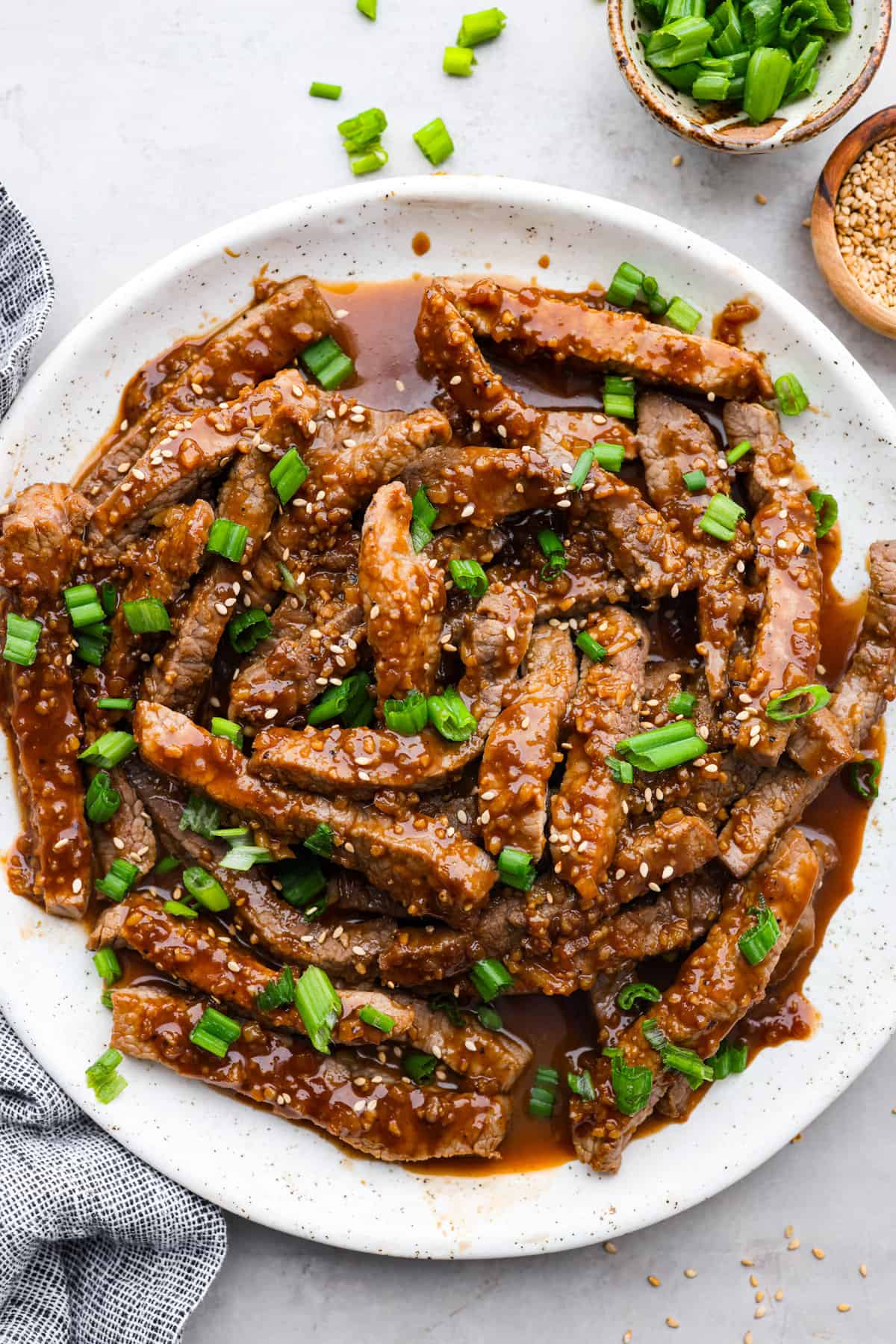This website may include affiliate links and advertisements, which help us share delicious recipes with you. Please review my disclosure policy for more information.
Discover the delightful simplicity of Korean Beef Bulgogi! This dish is not only quick to prepare but also requires no exotic ingredients. In just 45 minutes—10 of which are spent on prep and cooking—you can enjoy tender, flavorful beef that melts in your mouth. It’s an ideal choice for busy families looking for a satisfying dinner option.
If you’re interested in exploring more beef recipes, our blog features a variety of fantastic dishes such as Thai Basil Beef, Slow Cooker Korean Beef, One-Pot Beef Stroganoff, and Garlic Herb Butter Tenderloin.
A Flavorful Dinner Option
Looking to elevate your dinner routine with something surprisingly easy? Korean Beef Bulgogi is the perfect solution! This classic Korean BBQ dish features flank steak marinated to perfection in a sweet and savory sauce that will have everyone at the table asking for seconds.
### Picky Eater Approved!
When I first attempted this recipe at home, I anticipated a lengthy process filled with hard-to-find ingredients due to its rich flavors and incredibly tender meat. Fortunately, this bulgogi recipe utilizes simple pantry staples that you likely already have on hand!
Key Ingredients for the Marinade
The magic begins with the marinade. While many recipes suggest marinating overnight, I find that 30 minutes is sufficient when using beef—making this bulgogi both quick and convenient!
- Minced Pear: A key ingredient in Korean cuisine; it acts as a natural meat tenderizer while adding sweetness.
- Minced Garlic: Infuses savory flavor into the beef.
- Grated Ginger: Brightens up the overall taste profile.
- Soy Sauce: The base of our marinade; opt for low-sodium if preferred.
- Sesame Oil: Adds nuttiness while keeping everything moist.
- Sriracha: Introduces a hint of heat (feel free to substitute with gochujang if desired).
- Lime Juice: Enhances tenderness through acidity.
- Brown Sugar: Balances flavors with its sweetness.
- Seasonings: Onion powder and black pepper round out the marinade’s flavor.
Additional Ingredients Needed:
- Flank Steak: Thinly sliced into uniform strips for even cooking. - Vegetable Oil: For sautéing the bulgogi.
Choosing Your Cut of Beef
I recommend using flank steak cut into slices about 1/4 to 1/2 inch thick. Ribeye steaks are another excellent choice but tend to be pricier.
Cooking Instructions
You can prepare this dish either on a grill or stovetop. The thin slices cook quickly—just minutes! Ensure your grill or skillet is preheated before starting:
-
Prepare Marinade: In a large bowl, combine minced pear, garlic, ginger, soy sauce, sesame oil, sriracha (or gochujang), brown sugar, lime juice, onion powder, and black pepper.
-
Marinate: Add thinly sliced beef to the marinade mixture; cover it tightly and refrigerate for at least 30 minutes.
-
Cook: Heat vegetable oil in a large skillet over medium-high heat. Add some marinated beef slices in one layer without overcrowding them—this ensures proper caramelization! Cook each side for about 1–2 minutes until browned before removing them from the pan.
-
Serve: Enjoy over rice topped with sesame seeds if desired!
Important Cooking Tip
Avoid overcrowding your pan when cooking bulgogi; working in small batches allows each piece to sear properly instead of steaming—a crucial step toward achieving that sought-after smoky flavor!
Tips & Variations
Here are some additional suggestions to enhance your experience:
Marinating Time
While longer marination yields richer flavors (upwards of an hour), I typically stick with half an hour due to time constraints without sacrificing taste quality.
Side Dishes
Korean meals often feature ‘banchan’ or side dishes alongside main courses like bulgogi served over steamed rice complemented by colorful veggies such as chopped scallions or kimchi—and don’t forget pickled radish or cucumber slices!
Try ‘Ssam’
A popular way Koreans enjoy grilled meats involves wrapping them in leafy greens called ‘ssam.’ Simply take lettuce leaves filled with bulgogi along with extra sauce if desired—it’s fun eating these wraps whole!
Storing Leftovers & Reheating
Store any leftover bulgogi in an airtight container within your fridge where it will last up four days maximum! For reheating purposes aim towards medium heat on stovetops so you maintain those delicious textures/flavors intact during warming sessions.
For more incredible Korean-inspired recipes check out our Asian Korean Short Ribs recipe too!
Originally posted on October 7th ,2020
Updated February 11th ,2024
Nutritional Information per serving (approximate): Calories -490 kcal | Carbohydrates -16 g | Protein -51 g | Fat -24 g | Saturated Fat -7 g | Polyunsaturated Fat -7 g | Monounsaturated Fat –8 g| Trans Fat –0 .1 g| Cholesterol –136 mg| Sodium –1258 mg| Potassium –896 mg| Fiber –1 g| Sugar –11 g| Vitamin A–12 IU| Vitamin C–5 mg Calcium–74mg Iron–4mg
Note: Nutrition values are automatically calculated estimates meant solely as approximations.
About Alyssa Rivers
Alyssa Rivers is not only an accomplished food photographer but also author behind ’The Tried-and-Tested Cookbook’ who has developed numerous successful recipes featured across platforms like Good Morning America & Buzzfeed among others—all stemming from her passion towards culinary arts!

